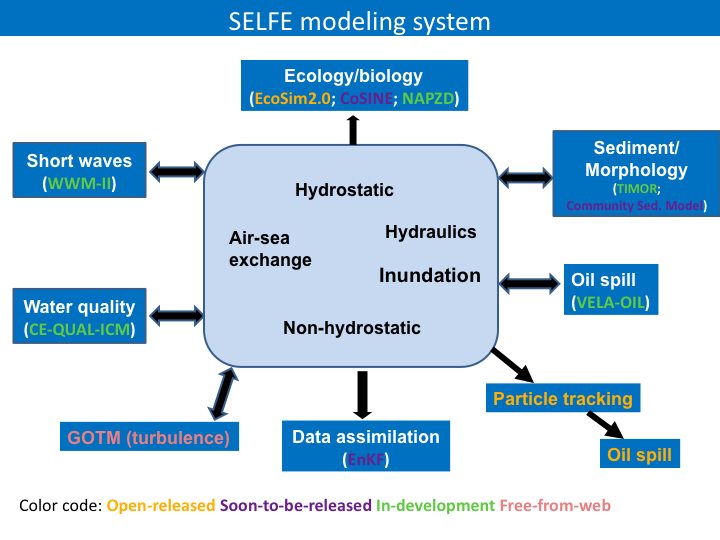You are here
SELFE - Related Modules
Ecology/biology
- EcoSim2.0: EcoSim2.0 is an ecological/optical modeling system that has been developed for many applications, including nowcast/forecast (for reference see http://feri.s3.amazonaws.com/pubs_ppts/FERI_2004_0002_U_D.pdf). An application of the coupled SELFE-EcoSim can be found in Rodrigues et al. (2009).
- CoSINE (Carbon, Si(OH)4, Nitrogen Ecosystem): Model developed as a collaboration between Chai and Dugdale (Chai et al. 2002, Dugdale et al. 2002). The CoSiNE model includes silicate, nitrate and ammonium, two phytoplankton groups, two zooplankton grazers, two detrital pools, TCO2. Recently oxygen has been added to constrain remineralization processes in the model. CoSINE is being coupled to SELFE in the context of a NASA-IDS sponsored project studying Pacific salmon in the San Francisco Bay and Delta.
- NAPZD: 5-component model originally developed by Dr. Yvette Spitz at Oregon State University, and being applied and modified by the multi-institutional CMOP modeling team
Short Waves
WWM-II: WWM-II is based on the source code by Hsu et al. (2005) but has since been overhauled by Roland (2009) in nearly all aspects of numerical schemes, physics, robustness and the efficiency to its present form (hence WWM-II). The WWM-II incorporates the framework of Residual distribution schemes (see e.g. Abgrall 2006) within a hybrid fractional splitting method utilizing third order Ultimate Quickest schemes in spectral space, as also used by Tolman (1992) in the Wave Watch III (WWIII) model, and robust and accurate integration of the source terms based on a multiple splitting technique using TVD-Runge Kutta schemes for shallow water wave breaking and bottom friction, dynamic integration of the triad interaction source term and semi-implicit integration of the deep water physics.
Water Quality
CE-QUAL-ICM: Integrated Compartment Model (ICM) water quality model was initially developed as one component of a model package employed to study eutrophication processes in Chesapeake Bay. Subsequent to employment in the Bay study, the model code was generalized and minor corrections and improvements were installed. (https://el.erdc.dren.mil/elmodels/icminfo.html)
GOTM (turbulence)
This module can be downloaded from the official GOTM website: www.gotm.net
Data Assimilation
EnKF: Model-independent data assimilation model is based on ensemble Kalman filter technique. The forward model is accelerated using a model “surrogate” which is then used to train a statistic model. Some details can be found in Frolov et al. (2008).
Particle tracking
3D tracking code included in the source code bundle is specifically written to read in the outputs from SELFE, and uses the tracking routine of the latter as its backbone. It can handle wetting and drying and is 3D in nature. Many user developed modules are based on this code, an example of which is the simple oil spill model developed by Dr. Yun Jung during his stay at OHSU/CMOP.
Oil Spill
VELA-OIL: this comprehensive oil spill model incorporates distinct natures of the surface and water column fluids, and the retention/reposition processes at the coast. Depending on the specific problem, this system can be efficiently used in 2D mode, for the surface slick, or in fully 3D mode, where the major processes at the surface and in the water column are accounted for. Likewise, the detailed formulation for coastal retention/reposition processes is also optional, as well as all weathering processes, for which well-established formulations are available. An example of the application of this model can be seen in Azevedo et al. (2009).
Sediment/Morphology
- TIMOR: this sediment and morphological model is being developed and maintained at Technical Univ. of Darmsdadt (Germany).
- Community Sediment Model: this model is adapted from Warner et al. (2008).
References
Azevedo, A., A. Oliveira, A.B. Fortunato and X. Bertin (2009) Application of an Eulerian-Lagrangian oil spill modeling system to the Prestige accident: trajectory analysis, J. Coastal Research, SI56: 777-781.
Chai, F., R. Dugdale, T.Peng, and F. Wilkerson (2002) Deep Sea Research.
Dugdale, R., R. Barber, F. Chai, and T.Peng (2002) Deep Sea Research.
Frolov, S., A.M. Baptista, M. Wilkin, (accepted). Optimizing Placement of Fixed Observational Sensors in a Coastal Observatory, Continental Shelf Research.
Rodrigues, M., A. Oliveira, H. Queiroga, A.B. Fortunato and Y.J. Zhang (2009) Three-Dimensional Modeling of the Lower Trophic Levels in the Ria de Aveiro (Portugal), Ecological Modelling, 220, 1274-1290.
Warner, J.C., Sherwood, C.R., Signell, R.P., Harris, C.K., Arango, H.G., 2008. Development of a three-dimensional, regional, coupled wave, current, and sediment-transport model. Computers & Geosciences, 34, 1284-1306.




